Classical vs. Neoclassical Theories: Organisation Management
VerifiedAdded on 2023/06/14
|8
|2366
|369
Essay
AI Summary
This essay provides an overview of classical and neoclassical organizational theories, examining their development, key concepts, and applications in managing business organizations. It discusses classical theory's emphasis on efficiency through scientific management, division of labor, and hierarchical structure, as well as neoclassical theory's focus on human behavior, social factors, and informal organization. The essay also touches on contemporary marketing orientations, culture excellence approaches, Japanese quality management, and organizational learning, highlighting their impact on shaping organizational structures and performance. The document concludes that organizational theories are essential for improving organizational effectiveness and adapting to evolving business environments. Desklib provides access to this document and a wealth of other resources to support student learning.
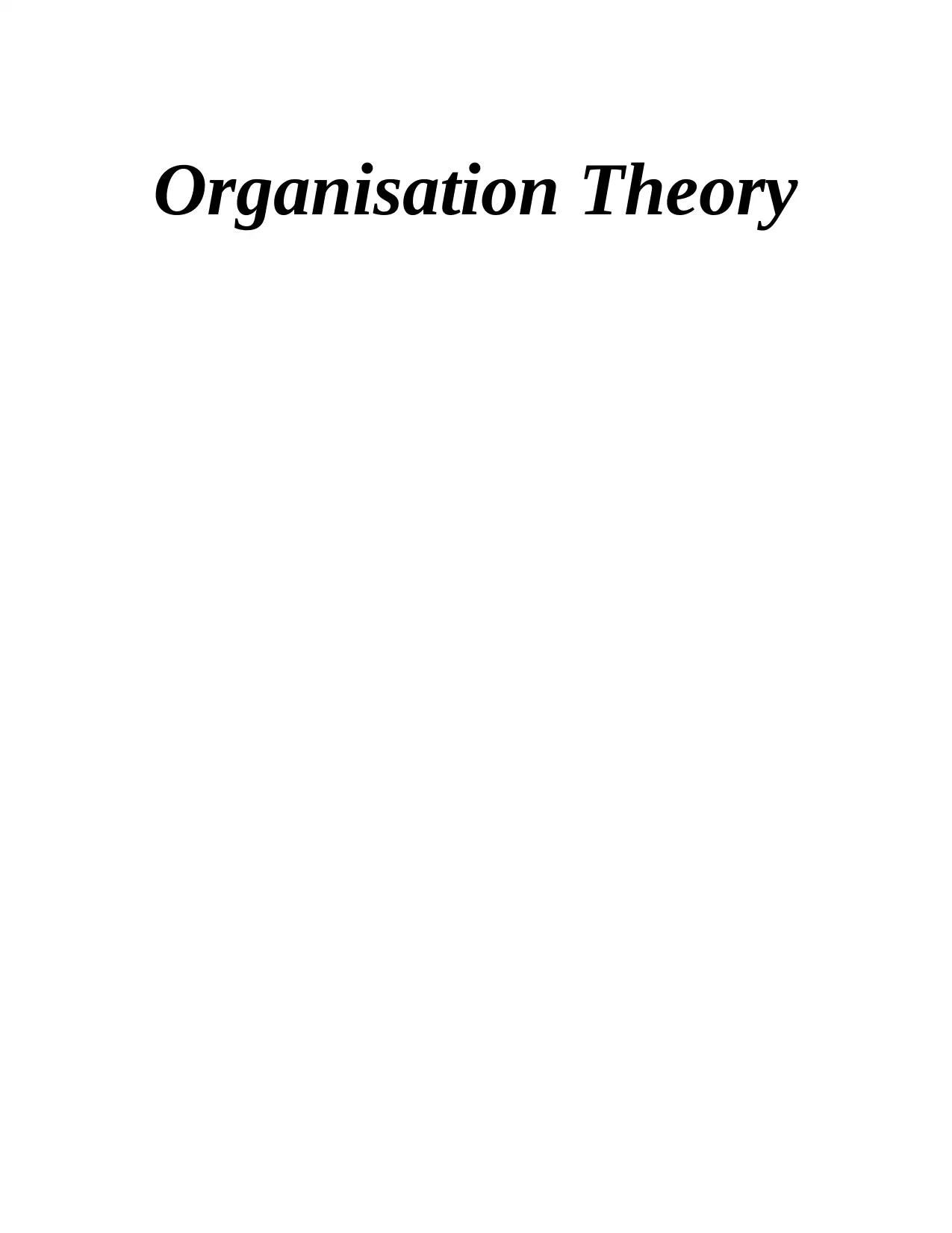
Organisation Theory
Paraphrase This Document
Need a fresh take? Get an instant paraphrase of this document with our AI Paraphraser

Table of Contents
INTRODUCTION...........................................................................................................................1
MAIN BODY...................................................................................................................................1
CONCLUSION................................................................................................................................5
References:.......................................................................................................................................6
INTRODUCTION...........................................................................................................................1
MAIN BODY...................................................................................................................................1
CONCLUSION................................................................................................................................5
References:.......................................................................................................................................6
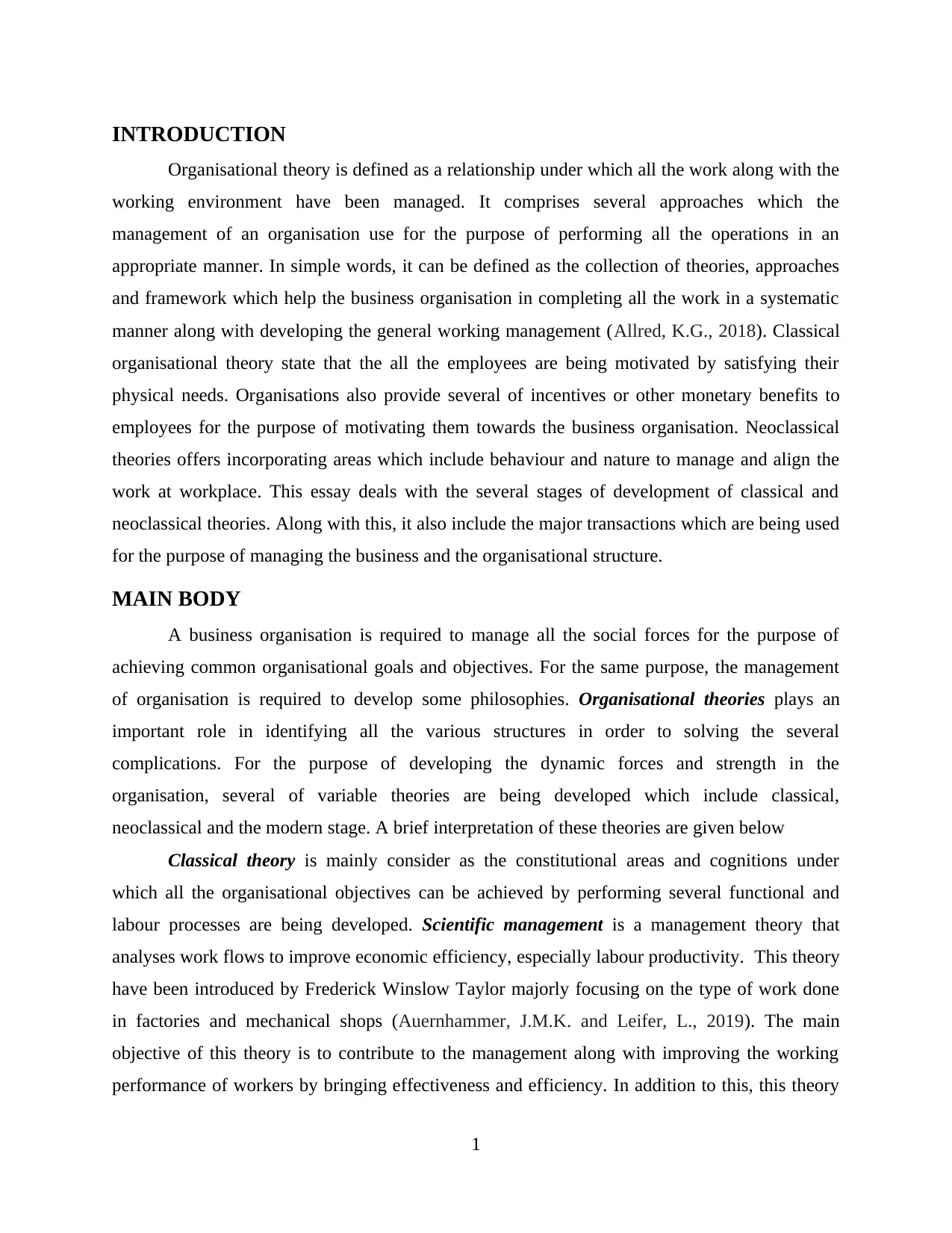
INTRODUCTION
Organisational theory is defined as a relationship under which all the work along with the
working environment have been managed. It comprises several approaches which the
management of an organisation use for the purpose of performing all the operations in an
appropriate manner. In simple words, it can be defined as the collection of theories, approaches
and framework which help the business organisation in completing all the work in a systematic
manner along with developing the general working management (Allred, K.G., 2018). Classical
organisational theory state that the all the employees are being motivated by satisfying their
physical needs. Organisations also provide several of incentives or other monetary benefits to
employees for the purpose of motivating them towards the business organisation. Neoclassical
theories offers incorporating areas which include behaviour and nature to manage and align the
work at workplace. This essay deals with the several stages of development of classical and
neoclassical theories. Along with this, it also include the major transactions which are being used
for the purpose of managing the business and the organisational structure.
MAIN BODY
A business organisation is required to manage all the social forces for the purpose of
achieving common organisational goals and objectives. For the same purpose, the management
of organisation is required to develop some philosophies. Organisational theories plays an
important role in identifying all the various structures in order to solving the several
complications. For the purpose of developing the dynamic forces and strength in the
organisation, several of variable theories are being developed which include classical,
neoclassical and the modern stage. A brief interpretation of these theories are given below
Classical theory is mainly consider as the constitutional areas and cognitions under
which all the organisational objectives can be achieved by performing several functional and
labour processes are being developed. Scientific management is a management theory that
analyses work flows to improve economic efficiency, especially labour productivity. This theory
have been introduced by Frederick Winslow Taylor majorly focusing on the type of work done
in factories and mechanical shops (Auernhammer, J.M.K. and Leifer, L., 2019). The main
objective of this theory is to contribute to the management along with improving the working
performance of workers by bringing effectiveness and efficiency. In addition to this, this theory
1
Organisational theory is defined as a relationship under which all the work along with the
working environment have been managed. It comprises several approaches which the
management of an organisation use for the purpose of performing all the operations in an
appropriate manner. In simple words, it can be defined as the collection of theories, approaches
and framework which help the business organisation in completing all the work in a systematic
manner along with developing the general working management (Allred, K.G., 2018). Classical
organisational theory state that the all the employees are being motivated by satisfying their
physical needs. Organisations also provide several of incentives or other monetary benefits to
employees for the purpose of motivating them towards the business organisation. Neoclassical
theories offers incorporating areas which include behaviour and nature to manage and align the
work at workplace. This essay deals with the several stages of development of classical and
neoclassical theories. Along with this, it also include the major transactions which are being used
for the purpose of managing the business and the organisational structure.
MAIN BODY
A business organisation is required to manage all the social forces for the purpose of
achieving common organisational goals and objectives. For the same purpose, the management
of organisation is required to develop some philosophies. Organisational theories plays an
important role in identifying all the various structures in order to solving the several
complications. For the purpose of developing the dynamic forces and strength in the
organisation, several of variable theories are being developed which include classical,
neoclassical and the modern stage. A brief interpretation of these theories are given below
Classical theory is mainly consider as the constitutional areas and cognitions under
which all the organisational objectives can be achieved by performing several functional and
labour processes are being developed. Scientific management is a management theory that
analyses work flows to improve economic efficiency, especially labour productivity. This theory
have been introduced by Frederick Winslow Taylor majorly focusing on the type of work done
in factories and mechanical shops (Auernhammer, J.M.K. and Leifer, L., 2019). The main
objective of this theory is to contribute to the management along with improving the working
performance of workers by bringing effectiveness and efficiency. In addition to this, this theory
1
⊘ This is a preview!⊘
Do you want full access?
Subscribe today to unlock all pages.

Trusted by 1+ million students worldwide

also plays an important role in preventing the wastage of time, reducing cost of production,
developing the relationship among the managers and workers which also result in bringing
efficiency in performance and retain them in the organisation. Major implicating areas include
the span of control along with the division of labour and structure. This theory state that the
growth of a business organisation is only possible by the growth of human capital working in the
organisation. This theory plays an important role in streaming the scientific and administrative
management under which the operative level of working have been framed. The scientific groups
are being made which help the business organisation in completing all the tasks in operative
level. The classical theory also helps in making the division of labour so that the working
performance of labour can be improved. It also leads to the bringing efficiency in working
performance of employees which is beneficial for the entire organisation. Classical theory get the
support of Scalar process in managing the growth of entire organisation along with the growth of
chain command with the degree of authority. Basically, it leads to the division of work in the
several groups and departments. Structure is consider as the another element under which all the
people, task and activities are being classified as per the positions which help the business
organisation in achieving the organisational goals and objectives in an effective and efficient
manner. The last element of classical theory is Span of control under which all the subordinates
are being managed by the managers as per the knowledge and capacity of workers. For the
purpose of managing the general transitions, several working classical theory have been
developed by the expansion of systematic administration along with the development of adequate
areas and principles of working nature.
Neoclassical Theory describe the process of paying high attention on the physiological
and mechanical variables for the purpose of managing the functions of organisation by the use of
mechanical variables and nature. Elton Mayo state that the human behaviour of employees
working in the organisation is the main reason for bringing changes in the products or services
because of the changes in the physiological areas. The Hawthorne Studies were conducted on
the workers working at the Hawthorne plant of the western Electric Company by Elton Mayo
and Fritz Roethlisberger in the 1920s. It involve two major elements which are being undertaken
are the situation on the technical, social and economic terms along with the social process under
which all the clinical analogues are being taken for human. Basically, this theory create the
boundaries in formal and informal forms in the organisation which help the management in
2
developing the relationship among the managers and workers which also result in bringing
efficiency in performance and retain them in the organisation. Major implicating areas include
the span of control along with the division of labour and structure. This theory state that the
growth of a business organisation is only possible by the growth of human capital working in the
organisation. This theory plays an important role in streaming the scientific and administrative
management under which the operative level of working have been framed. The scientific groups
are being made which help the business organisation in completing all the tasks in operative
level. The classical theory also helps in making the division of labour so that the working
performance of labour can be improved. It also leads to the bringing efficiency in working
performance of employees which is beneficial for the entire organisation. Classical theory get the
support of Scalar process in managing the growth of entire organisation along with the growth of
chain command with the degree of authority. Basically, it leads to the division of work in the
several groups and departments. Structure is consider as the another element under which all the
people, task and activities are being classified as per the positions which help the business
organisation in achieving the organisational goals and objectives in an effective and efficient
manner. The last element of classical theory is Span of control under which all the subordinates
are being managed by the managers as per the knowledge and capacity of workers. For the
purpose of managing the general transitions, several working classical theory have been
developed by the expansion of systematic administration along with the development of adequate
areas and principles of working nature.
Neoclassical Theory describe the process of paying high attention on the physiological
and mechanical variables for the purpose of managing the functions of organisation by the use of
mechanical variables and nature. Elton Mayo state that the human behaviour of employees
working in the organisation is the main reason for bringing changes in the products or services
because of the changes in the physiological areas. The Hawthorne Studies were conducted on
the workers working at the Hawthorne plant of the western Electric Company by Elton Mayo
and Fritz Roethlisberger in the 1920s. It involve two major elements which are being undertaken
are the situation on the technical, social and economic terms along with the social process under
which all the clinical analogues are being taken for human. Basically, this theory create the
boundaries in formal and informal forms in the organisation which help the management in
2
Paraphrase This Document
Need a fresh take? Get an instant paraphrase of this document with our AI Paraphraser
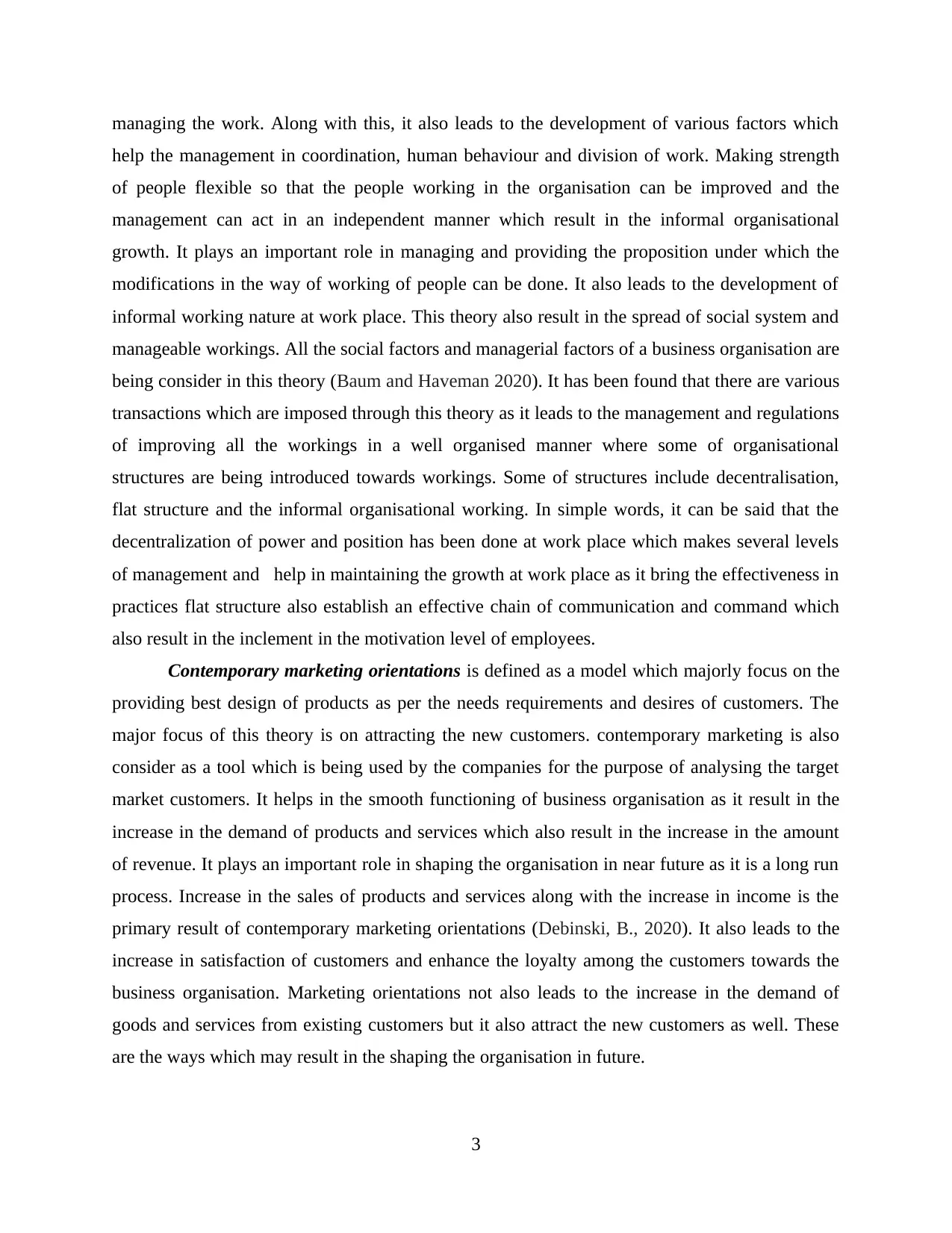
managing the work. Along with this, it also leads to the development of various factors which
help the management in coordination, human behaviour and division of work. Making strength
of people flexible so that the people working in the organisation can be improved and the
management can act in an independent manner which result in the informal organisational
growth. It plays an important role in managing and providing the proposition under which the
modifications in the way of working of people can be done. It also leads to the development of
informal working nature at work place. This theory also result in the spread of social system and
manageable workings. All the social factors and managerial factors of a business organisation are
being consider in this theory (Baum and Haveman 2020). It has been found that there are various
transactions which are imposed through this theory as it leads to the management and regulations
of improving all the workings in a well organised manner where some of organisational
structures are being introduced towards workings. Some of structures include decentralisation,
flat structure and the informal organisational working. In simple words, it can be said that the
decentralization of power and position has been done at work place which makes several levels
of management and help in maintaining the growth at work place as it bring the effectiveness in
practices flat structure also establish an effective chain of communication and command which
also result in the inclement in the motivation level of employees.
Contemporary marketing orientations is defined as a model which majorly focus on the
providing best design of products as per the needs requirements and desires of customers. The
major focus of this theory is on attracting the new customers. contemporary marketing is also
consider as a tool which is being used by the companies for the purpose of analysing the target
market customers. It helps in the smooth functioning of business organisation as it result in the
increase in the demand of products and services which also result in the increase in the amount
of revenue. It plays an important role in shaping the organisation in near future as it is a long run
process. Increase in the sales of products and services along with the increase in income is the
primary result of contemporary marketing orientations (Debinski, B., 2020). It also leads to the
increase in satisfaction of customers and enhance the loyalty among the customers towards the
business organisation. Marketing orientations not also leads to the increase in the demand of
goods and services from existing customers but it also attract the new customers as well. These
are the ways which may result in the shaping the organisation in future.
3
help the management in coordination, human behaviour and division of work. Making strength
of people flexible so that the people working in the organisation can be improved and the
management can act in an independent manner which result in the informal organisational
growth. It plays an important role in managing and providing the proposition under which the
modifications in the way of working of people can be done. It also leads to the development of
informal working nature at work place. This theory also result in the spread of social system and
manageable workings. All the social factors and managerial factors of a business organisation are
being consider in this theory (Baum and Haveman 2020). It has been found that there are various
transactions which are imposed through this theory as it leads to the management and regulations
of improving all the workings in a well organised manner where some of organisational
structures are being introduced towards workings. Some of structures include decentralisation,
flat structure and the informal organisational working. In simple words, it can be said that the
decentralization of power and position has been done at work place which makes several levels
of management and help in maintaining the growth at work place as it bring the effectiveness in
practices flat structure also establish an effective chain of communication and command which
also result in the inclement in the motivation level of employees.
Contemporary marketing orientations is defined as a model which majorly focus on the
providing best design of products as per the needs requirements and desires of customers. The
major focus of this theory is on attracting the new customers. contemporary marketing is also
consider as a tool which is being used by the companies for the purpose of analysing the target
market customers. It helps in the smooth functioning of business organisation as it result in the
increase in the demand of products and services which also result in the increase in the amount
of revenue. It plays an important role in shaping the organisation in near future as it is a long run
process. Increase in the sales of products and services along with the increase in income is the
primary result of contemporary marketing orientations (Debinski, B., 2020). It also leads to the
increase in satisfaction of customers and enhance the loyalty among the customers towards the
business organisation. Marketing orientations not also leads to the increase in the demand of
goods and services from existing customers but it also attract the new customers as well. These
are the ways which may result in the shaping the organisation in future.
3
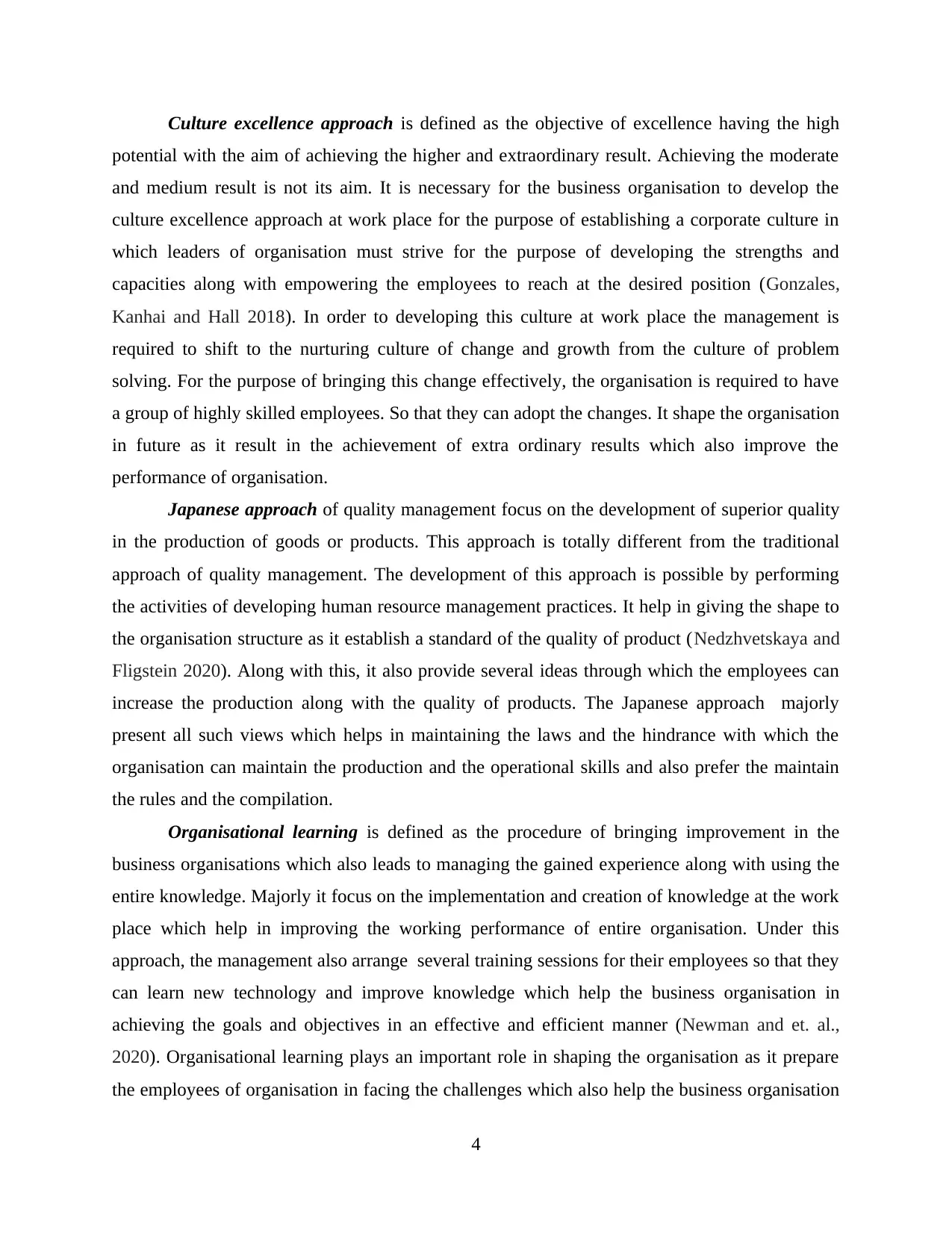
Culture excellence approach is defined as the objective of excellence having the high
potential with the aim of achieving the higher and extraordinary result. Achieving the moderate
and medium result is not its aim. It is necessary for the business organisation to develop the
culture excellence approach at work place for the purpose of establishing a corporate culture in
which leaders of organisation must strive for the purpose of developing the strengths and
capacities along with empowering the employees to reach at the desired position (Gonzales,
Kanhai and Hall 2018). In order to developing this culture at work place the management is
required to shift to the nurturing culture of change and growth from the culture of problem
solving. For the purpose of bringing this change effectively, the organisation is required to have
a group of highly skilled employees. So that they can adopt the changes. It shape the organisation
in future as it result in the achievement of extra ordinary results which also improve the
performance of organisation.
Japanese approach of quality management focus on the development of superior quality
in the production of goods or products. This approach is totally different from the traditional
approach of quality management. The development of this approach is possible by performing
the activities of developing human resource management practices. It help in giving the shape to
the organisation structure as it establish a standard of the quality of product (Nedzhvetskaya and
Fligstein 2020). Along with this, it also provide several ideas through which the employees can
increase the production along with the quality of products. The Japanese approach majorly
present all such views which helps in maintaining the laws and the hindrance with which the
organisation can maintain the production and the operational skills and also prefer the maintain
the rules and the compilation.
Organisational learning is defined as the procedure of bringing improvement in the
business organisations which also leads to managing the gained experience along with using the
entire knowledge. Majorly it focus on the implementation and creation of knowledge at the work
place which help in improving the working performance of entire organisation. Under this
approach, the management also arrange several training sessions for their employees so that they
can learn new technology and improve knowledge which help the business organisation in
achieving the goals and objectives in an effective and efficient manner (Newman and et. al.,
2020). Organisational learning plays an important role in shaping the organisation as it prepare
the employees of organisation in facing the challenges which also help the business organisation
4
potential with the aim of achieving the higher and extraordinary result. Achieving the moderate
and medium result is not its aim. It is necessary for the business organisation to develop the
culture excellence approach at work place for the purpose of establishing a corporate culture in
which leaders of organisation must strive for the purpose of developing the strengths and
capacities along with empowering the employees to reach at the desired position (Gonzales,
Kanhai and Hall 2018). In order to developing this culture at work place the management is
required to shift to the nurturing culture of change and growth from the culture of problem
solving. For the purpose of bringing this change effectively, the organisation is required to have
a group of highly skilled employees. So that they can adopt the changes. It shape the organisation
in future as it result in the achievement of extra ordinary results which also improve the
performance of organisation.
Japanese approach of quality management focus on the development of superior quality
in the production of goods or products. This approach is totally different from the traditional
approach of quality management. The development of this approach is possible by performing
the activities of developing human resource management practices. It help in giving the shape to
the organisation structure as it establish a standard of the quality of product (Nedzhvetskaya and
Fligstein 2020). Along with this, it also provide several ideas through which the employees can
increase the production along with the quality of products. The Japanese approach majorly
present all such views which helps in maintaining the laws and the hindrance with which the
organisation can maintain the production and the operational skills and also prefer the maintain
the rules and the compilation.
Organisational learning is defined as the procedure of bringing improvement in the
business organisations which also leads to managing the gained experience along with using the
entire knowledge. Majorly it focus on the implementation and creation of knowledge at the work
place which help in improving the working performance of entire organisation. Under this
approach, the management also arrange several training sessions for their employees so that they
can learn new technology and improve knowledge which help the business organisation in
achieving the goals and objectives in an effective and efficient manner (Newman and et. al.,
2020). Organisational learning plays an important role in shaping the organisation as it prepare
the employees of organisation in facing the challenges which also help the business organisation
4
⊘ This is a preview!⊘
Do you want full access?
Subscribe today to unlock all pages.

Trusted by 1+ million students worldwide
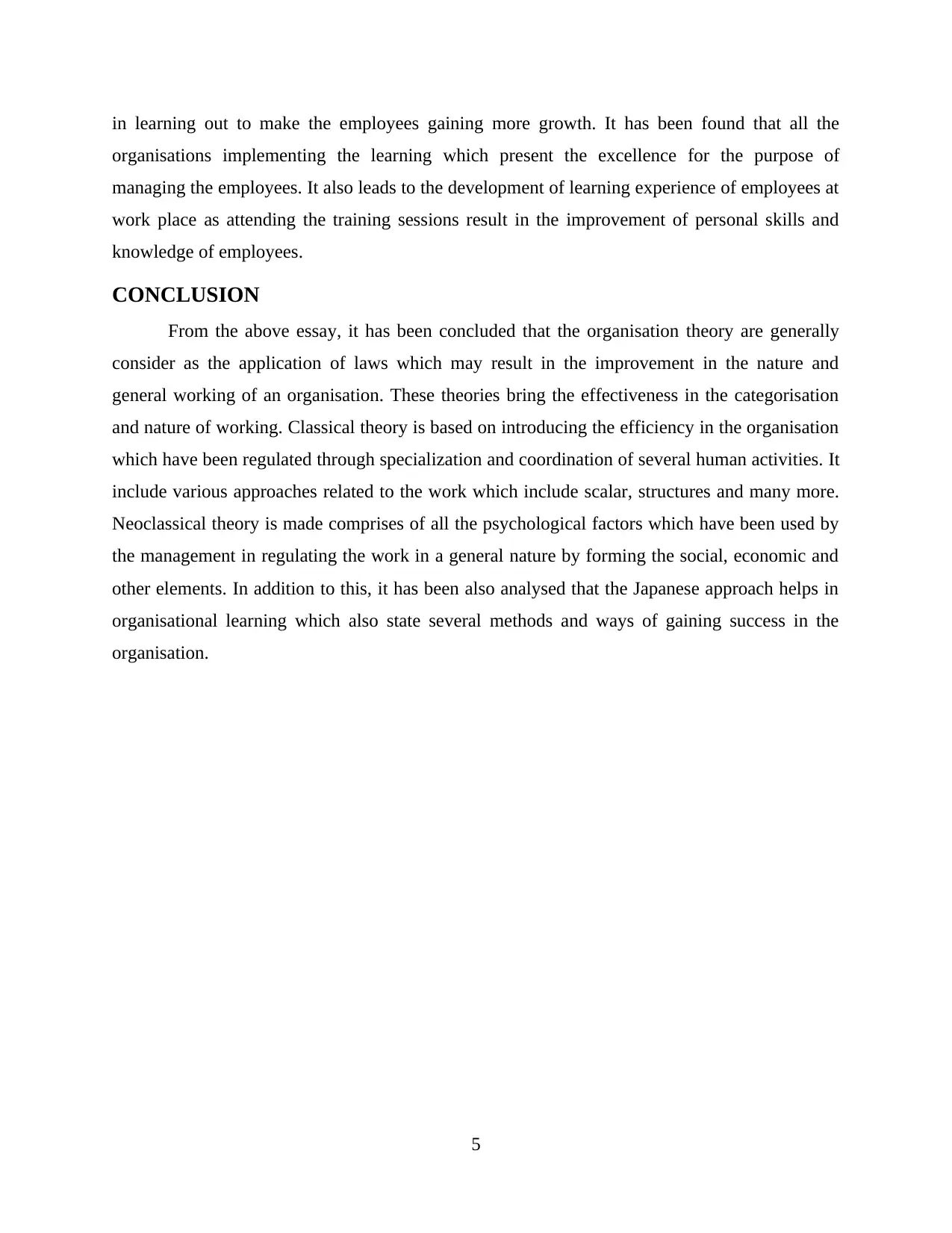
in learning out to make the employees gaining more growth. It has been found that all the
organisations implementing the learning which present the excellence for the purpose of
managing the employees. It also leads to the development of learning experience of employees at
work place as attending the training sessions result in the improvement of personal skills and
knowledge of employees.
CONCLUSION
From the above essay, it has been concluded that the organisation theory are generally
consider as the application of laws which may result in the improvement in the nature and
general working of an organisation. These theories bring the effectiveness in the categorisation
and nature of working. Classical theory is based on introducing the efficiency in the organisation
which have been regulated through specialization and coordination of several human activities. It
include various approaches related to the work which include scalar, structures and many more.
Neoclassical theory is made comprises of all the psychological factors which have been used by
the management in regulating the work in a general nature by forming the social, economic and
other elements. In addition to this, it has been also analysed that the Japanese approach helps in
organisational learning which also state several methods and ways of gaining success in the
organisation.
5
organisations implementing the learning which present the excellence for the purpose of
managing the employees. It also leads to the development of learning experience of employees at
work place as attending the training sessions result in the improvement of personal skills and
knowledge of employees.
CONCLUSION
From the above essay, it has been concluded that the organisation theory are generally
consider as the application of laws which may result in the improvement in the nature and
general working of an organisation. These theories bring the effectiveness in the categorisation
and nature of working. Classical theory is based on introducing the efficiency in the organisation
which have been regulated through specialization and coordination of several human activities. It
include various approaches related to the work which include scalar, structures and many more.
Neoclassical theory is made comprises of all the psychological factors which have been used by
the management in regulating the work in a general nature by forming the social, economic and
other elements. In addition to this, it has been also analysed that the Japanese approach helps in
organisational learning which also state several methods and ways of gaining success in the
organisation.
5
Paraphrase This Document
Need a fresh take? Get an instant paraphrase of this document with our AI Paraphraser

References:
Books and Journals
Allred, K.G., 2018. Realizing the Advantages of Organizational Interdependences: The Role of
Attribution Ally Mediated Emotions. In Attribution Theory (pp. 253-271). Routledge.
Auernhammer, J.M.K. and Leifer, L., 2019, July. Is organizational design a human-centered
design practice?. In Proceedings of the Design Society: International Conference on
Engineering Design (Vol. 1, No. 1, pp. 1205-1214). Cambridge University Press.
Baum, J.A. and Haveman, H.A., 2020. Editors’ comments: the future of organizational
theory. Academy of Management Review, 45(2), pp.268-272.
Debinski, B., 2020. Applying Organizational Theory to Assess Intimate Partner Violence
Prevention and Response in the Catholic Church: A Case Study of the Archdiocese of
Chicago Domestic Violence Outreach Ministry (Doctoral dissertation, Johns Hopkins
University).
Gonzales, L.D., Kanhai, D. and Hall, K., 2018. Reimagining organizational theory for the critical
study of higher education. In Higher education: Handbook of theory and research (pp.
505-559). Springer, Cham.
Nedzhvetskaya, N. and Fligstein, N., 2020. The evolving role of organizational theory within
economic sociology. Sociology Compass, 14(3), p.e12747.
Newman, D., Newman, I. and Hitchcock, J.H., 2020. Applications of Longitudinal Research to
Advance Organizational Theory: A Primer. In Cognitive Analytics: Concepts,
Methodologies, Tools, and Applications (pp. 1175-1195). IGI Global.
Strati, A., 2018. Organizational theory and aesthetic philosophies. Routledge.
6
Books and Journals
Allred, K.G., 2018. Realizing the Advantages of Organizational Interdependences: The Role of
Attribution Ally Mediated Emotions. In Attribution Theory (pp. 253-271). Routledge.
Auernhammer, J.M.K. and Leifer, L., 2019, July. Is organizational design a human-centered
design practice?. In Proceedings of the Design Society: International Conference on
Engineering Design (Vol. 1, No. 1, pp. 1205-1214). Cambridge University Press.
Baum, J.A. and Haveman, H.A., 2020. Editors’ comments: the future of organizational
theory. Academy of Management Review, 45(2), pp.268-272.
Debinski, B., 2020. Applying Organizational Theory to Assess Intimate Partner Violence
Prevention and Response in the Catholic Church: A Case Study of the Archdiocese of
Chicago Domestic Violence Outreach Ministry (Doctoral dissertation, Johns Hopkins
University).
Gonzales, L.D., Kanhai, D. and Hall, K., 2018. Reimagining organizational theory for the critical
study of higher education. In Higher education: Handbook of theory and research (pp.
505-559). Springer, Cham.
Nedzhvetskaya, N. and Fligstein, N., 2020. The evolving role of organizational theory within
economic sociology. Sociology Compass, 14(3), p.e12747.
Newman, D., Newman, I. and Hitchcock, J.H., 2020. Applications of Longitudinal Research to
Advance Organizational Theory: A Primer. In Cognitive Analytics: Concepts,
Methodologies, Tools, and Applications (pp. 1175-1195). IGI Global.
Strati, A., 2018. Organizational theory and aesthetic philosophies. Routledge.
6
1 out of 8
Related Documents
Your All-in-One AI-Powered Toolkit for Academic Success.
+13062052269
info@desklib.com
Available 24*7 on WhatsApp / Email
![[object Object]](/_next/static/media/star-bottom.7253800d.svg)
Unlock your academic potential
Copyright © 2020–2025 A2Z Services. All Rights Reserved. Developed and managed by ZUCOL.





